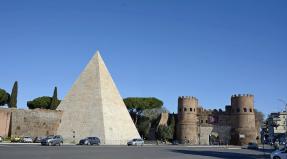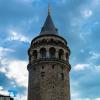Galata Tower (Istanbul, Turkey): history, photo, description. Galata Tower in Istanbul: how to get there, excursions, history
Updated 03/04/2019
The Galata Tower in Istanbul (in Turkish Galata Kulesi, in English - Galata Tower) is an integral symbol of the city. In any, more or less large metropolis, there is a dominant towering above all other buildings. Usually it serves as a symbol of the city and in parallel is one of the main tourist attractions. When asked who plays the dominant role in Paris, I think 99.99% will answer that the Eiffel Tower will be right, in London it’s Big Ben, in Tel Aviv it’s Azrieli’s skyscrapers, in Budapest it’s St. Stephen’s Basilica.
But today we will not talk about these cities. And what attraction can be called the dominant of Istanbul? Probably, someone will immediately think of a magnificent palace complex or unimaginable. And he might be right, but only partly. After all, despite the relatively small height, the Galata Tower is considered the dominant of Turkish Istanbul.
 It can be observed from almost all points of the central part of the city. The tower, like the eye of Sauron, beckons tourists and those willy-nilly find themselves at its foot. I turned out to be one of the most persistent travelers and visited the Galata Tower on the fourth day of the trip - the day before returning home.
It can be observed from almost all points of the central part of the city. The tower, like the eye of Sauron, beckons tourists and those willy-nilly find themselves at its foot. I turned out to be one of the most persistent travelers and visited the Galata Tower on the fourth day of the trip - the day before returning home.
History of the Galata Tower
As early as the 6th century AD, a watchtower stood in these places. It was erected by order of the Byzantine emperor Justinian I (under him, another famous landmark of Istanbul was completed -). It has not survived to this day, but since ancient times it has been customary to build something defensive on a hill. This is what the army of the Republic of Genoa did when it was able to recapture the area from the Byzantine Empire in the middle of the 14th century. It took them about a year to build the tower and the work was not in vain - the structure has survived to this day. The building became known as the "Jesus Tower". For a long time, it served not so much as a defensive object, but as a guide for sailors and merchants.
How the Sultan shortened the tower
It turned into the Galata Tower after the conquest of the lands by the Turks. Sultan of the Ottoman Empire Mehmed II the Conqueror ordered to reduce the height of the tower by almost 7 meters. So the building lost its dome. In the last quarter of the 16th century, that is, after about 100 years, the Galata Tower in Istanbul was used as an observatory. It should be noted that this is not the only purpose of the tower. She also acted as a prison and even a fire tower. However, read on and find out for yourself.
Many legends and fables are associated with the Galata Tower. One of them says that the scientist made wings and, attaching them to his hands, jumped off the tower. The learned husband was so lucky that he not only did not fall like a stone down and did not die a martyr's death, but also flew over the Bosphorus, after which he landed safely in the Asian part of Istanbul. The Sultan himself awarded the scientist for this flight. True, he was later expelled to Algiers. Why the ruler got rid of such a valuable frame is not clear.

At the end of the 17th century and almost 40 years later, the tower underwent two reconstructions. After the completion of the latter, the building acquired an observation deck. There were guards on it 24 hours a day, whose eyes were vigilantly watching the part of the city located on the northern bank of the Golden Horn. They reported to the authorities about the occurrence of fires or riots.
Close to the modern look, the Galata Tower in Istanbul acquired in 1875. Only in the 60s of the XX century it was slightly updated, including by rebuilding the dome. A little later, an elevator appeared in the tower.
Wikipedia says that the height of the tower is 61 meters, but the Turks themselves write that the Galata tower is not lower than 67 meters. The diameter of the structure is relatively small - only 9 meters.
Impressions from visiting the Galata Tower
My date with the Galata Tower took place the day before my flight to Russia, and in general it was four with a good plus. The day turned out to be sunny (perhaps it was the only one on the entire trip), so I was already looking forward to the views that would open up to me from a height of 140 meters above sea level (not to be confused with the height of the tower). On the Internet, the Galata Tower is often scolded for its long queues and the high price of an entrance ticket. I was lucky with the queue - there was no queue (some people wait downstairs for an hour), but read about the price below in the “Useful Information” section.
In total, the Galata Tower has nine floors, seven of which you will overcome by elevator. The last two floors are on foot - along a wooden spiral staircase. It is not very wide and rather steep, so you will have to hustle with those who have already enjoyed the panoramas of Istanbul. There is also a cafe with almost acceptable (read: inflated) prices. But a cup of tea for 6 liras or a cappuccino for 12 is accompanied by a gorgeous view outside the windows.
It is especially relevant in the cold season, when you don’t particularly find yourself on an open and windswept observation deck. But in my case, the month of May stood in the yard and I went out into the air.
Views of Istanbul from the top of the Galata Tower
The city (to be precise, a small part of it) lay in front of me at a glance. The observation deck stretches around the entire tower, so the panorama opens in all 360 degrees. Candles of minarets on one side, arrows of skyscrapers on the other, ships and boats scurrying along the Golden Horn on the third. In a word, beauty. Somewhere out there, the largest market in the city lives its own life - which is a must-see.





During the time that I spent upstairs, both the unpleasant surprise at the price of the entrance ticket and the pushing on the stairs were forgotten. I just adore panoramic views, so I highly advise you to climb the observation deck of the Galata Tower. But choose the time to visit and make allowances for the weather so as not to spoil the impression of the visit.





Useful information for visiting the Galata Tower
Official site: as far as I understand, it is not there, but there is a page dedicated to the Galata Tower on the official resource "Istanbul for tourists". His Internet address is istanbul-tourist-information.com.
The address: Bereketzade Mh. Galata Kulesi, Beyoglu.
Working hours: daily from 09:00 to 21:00.
Entrance ticket price: 20 lira
Galata tower on the map
How to get to the tower
If you live on Istiklal Street or nearby, you can get to the tower on foot.
From the Old City (Sultanahmet district), the easiest way to get there is by tram. You need to get off at the Karaköy stop, which will be the first after the Galata Bridge and take the Tünel underground funicular or climb the mountain on foot.
In addition, within walking distance from the tower there is a metro station Shishkhane (Şişhane) - the green line M2.
How to save money on public transport in Istanbul with (IstanbulKart).
Excursions with a visit to the Galata Tower
Looking for a hotel or apartment? Thousands of options on RoomGuru. Many hotels are cheaper than on Booking
Galata tower (Turkey) - description, history, location. Exact address, phone number, website. Reviews of tourists, photos and videos.
- Tours for the New Year to Turkey
- Hot tours to Turkey
Previous photo Next photo





The Galata Tower is one of the oldest monuments in Istanbul. To the impressive height of the tower itself (61 meters, despite the fact that it was built in the 14th century!) Is added the natural elevation of the hill of the same name - so Galata is perfectly visible from almost any area of the Turkish capital. And of course, such “visibility” could not but affect the popularity of the structure among tourists - no less travelers come to look at the miracle of medieval architecture than to other “promoted” sights of Istanbul.
A bit of history
The Galata Tower in its current version was built by the Genoese in the middle of the 14th century. Then, however, it had a different name - literally, "the tower of Christ" - and its construction was intended to perpetuate the fact of the expansion of the Genoese colonies of Constantinople. However, the Genoese were not pioneers on the Galata Hill - according to archaeological excavations, the advantageous position of the area began to be used as early as the 5th century, when the predecessor of Galata was erected here. For centuries, the Genoese Galata Tower was used both as a fire tower, and as a starting point for air travel (in 1633, a daredevil on artificial wings started from here), and as a place for panoramic shots of Istanbul. And in 1965, Galata was opened to the general public.
The Galata Tower is one of the most popular attractions. One day we decided to climb it and admire the panoramic views from a height of 67 meters! That's what came out of it…
Looking ahead, I will say that, in my opinion, the history of the Galata Tower is much more interesting than itself.
More in the 5th century on this very spot stood an ancient nameless tower.
Later, the Genoese expelled the Byzantines from here and founded their colony. In 1341 they began to surround their settlement with high walls. And just a couple of years later, the Tower of Jesus was built on top of the hill - an excellent landmark for merchants and sailors.
In 1453 after the conquest of Istanbul during the Ottoman period, the tower was renamed Galata. Then when the Sultan Mehmed the Conqueror removed the dome and reduced the height of the tower by almost 7 meters. Why did they not try to adapt this structure! For some time it served as an observatory, then a round-the-clock guard was on duty on the observation deck, and prisoners were kept on the lower floors.
A in 1632 the scientist Hezarfen Ahmet Celebi even used the highest point of the tower as a starting point… for flying! On homemade wings, he managed to fly over the Bosphorus and land in the Asian part of the city.
50 years ago, the Galata Tower was thoroughly restored, the dome was given a conical shape and an elevator was built in.
In a very condensed form, the history of the Galata Tower fit on a small tablet:
At the foot of the tower you feel like a midget:

2. Useful information
2.1. Where is
The tower can be seen from almost anywhere in the old center of Istanbul! It is located in the Galata region north of the Golden Horn, not far from the tourist Istiklal Street.
Location on the map:
It is difficult to confuse the Galata Tower with other sights of Istanbul:

2.2. How to get there
- By public transport
From the old part of the city (Fatih, Sultanahmet) by light rail you need to get to the Karakoy stop. From there, you will either have to climb the mountain on foot, or use the funicular.
- By taxi
Istanbul has a well-developed public transport system, so the easiest way to get there is by it. But ordering a taxi makes sense only if you can allocate just a few hours to see Istanbul, and you have large suitcases with you. True, keep in mind that you can easily stand in a traffic jam for quite a long time.
- Book an excursion
A one-day tour of Istanbul (from 33 euros) necessarily includes a visit to the Galata Tower. Very convenient, because in one day you can see all the most interesting sights. The tour can be booked both online and at the hotel, but it is much more interesting to go on a tour with one of the locals.
For example, there is a lot - during the tour you will not only see Istanbul from different angles, but also learn a lot about history and architecture firsthand.
You can see what excursions the locals offer here.
- On foot
From the area Taksim the easiest way to get to the tower. Walk to the end of the street Istiklal and go down the picturesque streets. You can also walk from the Sultanahmet area, combining the road to the tower with an exciting walk around Istanbul.
Personally, we got to the tower on foot (about half an hour). From there you need to go along the Galata Bridge and move on towards the tower.
In the area where the tower is located, you will have to climb the stairs:

It was possible to climb here too, but we decided to go a little further:

Gradually climbing, finally reached the destination:

Here she is:

2.3. Visit time
The Galata Tower is open to the public daily from 09.00 to 20.30.
2.4. Price
The price of the entrance ticket is 35 lira(and in my opinion, this is unreasonably much).
Tower visitors are divided into three categories: children, adults… and tourists:

My ticket:

By the way, the museum card does not work here:

3. Photo tour of the tower and views from it
On the ground floor of the tower there is a shop and cash desks:

I go up the elevator, then - on foot up the stairs:

On the "intermediate" floor - toilets and a poster with the history of the tower:

On the top floor there is an expensive restaurant and an observation deck. It seems that sky-high prices scared away not only me. Even in high season the restaurant is empty:

In my opinion, there is no point in dining in this restaurant - the tables are placed in the center of the hall, so you can’t even enjoy the view, there is no feeling that you are at the very top of the tower. Therefore, we immediately go to the observation deck.
View of the Galata Bridge:

View of the Bosphorus:

All the same magnificent Bosphorus:

Photo of Istanbul against a cloudy sky:

View of the Topkapi Palace (far away, on the green peninsula):

Cars and people below seem quite tiny. Still, 137 meters above sea level:

And on some roofs there are cafes:

Personally, I really missed the greenery on the streets in Istanbul, the buildings are very dense:

From here it seems that the houses were built literally a meter apart:

4. Conclusions
In my opinion, the cost of visiting this attraction is unreasonably high. For almost the same money, it is better to go to Topkapi Palace or, where it will be much more interesting.
There is practically nothing to look at in the tower itself: an elevator, a staircase for a couple of flights and a stand with the history of the tower.
History of the Galata Tower:

The only room inside the attraction is a restaurant with space prices.
There are few visitors, but still there are:

The tower is worth climbing just for the amazing views!
Agree, very beautiful!

In addition to photographing gorgeous views, there is absolutely nothing to do in the Galata Tower. The whole tour took me exactly 20 minutes, 15 of which I admired the panorama, photographed and filmed a video.
Unpleasantly surprised that the museum card for visiting the tower does not apply. Although this object is considered one of the most popular attractions in Istanbul.
5. Video
And here is a video with views of Istanbul from the observation deck of the Galata Tower:
What impression did the Galata tower make on you? Where else in Istanbul can you enjoy the views? Share in the comments! ( 3
votes, rating: 5,00
out of 5)
There is no exact information about the date of construction of the Galata Tower, but it is claimed that it was built in 507 AD. e. during the reign of Emperor Justinian. As historians say, back in the 5th century AD. e. there was a tower in these neighborhoods. However, the tower that has come down to our time dates back to 1348-1349. At that time, the Genoese dominated these lands. The Genoese captured the Byzantine areas and then built a tower here for defensive purposes and called it the "Tower of Jesus", and under this name it became one of the most important components of the 14th century fortification system that surrounded Galata. The Byzantines called it the Great Tower. In addition to towers and walls, the defense structures of the Genoese fortress also included fortress ditches, which are still indicated by the names of the old streets located next to the tower: Buyuk Hendek, which means the Big Ditch, and Kyuchuk Hendek, the Small Ditch.
The tower stands on a hillside, on the so-called Galata peak, located in the European part of the city. The tower was built in such a place that it is perfectly visible from almost all points of the city. From its top, a magnificent panorama opens up, which attracts the attention of tourists and guests of the city.
As a result of an earthquake that occurred in 1509, the tower was seriously damaged, and then it was restored and built on under the guidance of the famous Turkish Ottoman architect Hayreddin. The height of the Galata tower today is 66.90 m, its outer and inner diameters are 16.45 m and 8.95 m, respectively. The thickness of the wall is 3.75 m, and the height above sea level is 140 m.
In the 16th century, prisoners of war were kept in the tower. The prisoners were then usually sent to the galleys as slave laborers for the Ottoman arsenal, which was located in the Golden Horn at Qasimpass.
During the reign of Suleiman II in 1566-1574. the tower was used as an observation post by the famous Turkish astronomer Takiuddin. Its main observatory was located in Pera. During the reign of Mustafa II in 1695 - 1703. Feyzulla-Efendi attempted to equip an astronomical observatory here with the help of one Jesuit priest, but all his efforts were brought to naught. He was killed in 1703, and the tower, which served as an observatory, was closed by Sultan Murad III and again turned into a prison for convicts who worked at the Kasimpasa shipyard.
In the 17th century, during the Ottoman period, the Galata Tower got a new name - Khezarfen Kulesi, which means the Tower of Khezarfen. This name was assigned to it under Sultan Murad IV after the inventor Hezarfen Ahmet Celebi made wings for himself in 1638 and successfully flew from Galata to Uskudar. The brave jack-of-all-trades used the top floor of the tower as a launch pad. He became the first balloonist in Turkey.
In the tower, closer to the 17th century, they placed a brigade of firefighters, called mekhters in those days. After 1717, the Galata Tower became the main observation post of the city, and from its upper platform, special observers constantly monitored the surroundings day and night, and at the first detection of signs of smoke or fire in one of the districts, they beat the big drum, alerting firefighters and citizens of the danger. . However, by an ironic coincidence, it was during the fire that broke out in 1794 that the tower burned down. It was restored during the reign of Sultan Suleiman III. On the top floor, a jumba, the so-called ledge with a railing, was added. In 1831, the second fire broke out on the tower. After that, the tower was repaired by order of Sultan Mahmud II and two more levels were erected and the famous conical roof, as well as a stele with an inscription about the restoration of the tower, which belonged to the pen of Pertev Pasha. During a severe storm that occurred in 1875, the conical roof was demolished.
The Galata Tower was restored in 1967 by the Municipality of the City of Istanbul. The conical roof was placed again on top of the tower. The steep spiral stone staircase was also reconstructed. In order for tired tourists to find an alternative to the steep climb, two elevators were installed inside the tower. And for those who like to view the landscapes of Istanbul, there is a balcony on the top floor. It also has a restaurant, cafeteria and nightclub. The Galata Tower in Turkey is loved as a symbol that reminds them of the past. If you want to watch a colorful show, "belly dance" performed by local beauties or try local cuisine, then you just need to visit the Galata Tower in the evening.
On the site of the square, which today is occupied by the Galata Tower, a similar structure stood in the 5th century. However, later these lands, previously under the control of Byzantium, were conquered by the Genoese. The building known today appeared on the map of the Turkish capital in the middle of the 14th century. Its construction was carried out in 1348-1349. At that time, the structure performed quite trivial functions - it was a landmark for ships sailing from the bay. It began its history under the name "Jesus Tower". The Galata Tower was called during the reign of the Ottoman Empire here.
Over the years of its existence, the structure has been transformed several times. In the 15th century, by decision of the ruler, the dome was removed, which reduced the height by more than 6 meters. In the next century, it functioned as an observatory, and in the first half of the 17th century, it went down in history as the place from which the first flight was made using makeshift wings. According to historical data, in 1632, the local scientist Hezarfen Ahmet Chelebi was able to cross the Bosphorus using a makeshift device, starting from the top of the Galata Tower.
At the end of the 18th century, another addition awaited the building: in 1791 its height increased to 45 meters. A balcony for an observation deck appeared here in the first half of the 19th century, but initially it was not intended for travelers. Here the guards were on guard, who from this point immediately became visible any riots and fires in the city blocks. In the second half of the 20th century, the building was restored again and in 1965 it was opened to the public. In the same period, a dome was built on, and later an elevator was added to the construction of the structure.
Today, the height from the base to the top of the dome is 69.9 meters. The diameter has been preserved from past centuries - 9 meters. On the territory of the modern Galata Tower there is its own restaurant and club.
How to get there
The Galata tower rises in the central part of the city. Due to its height, it is visible from many points, which makes it easier to find a landmark. You can approach the building from the side of Galata Kulesi and Büyük Hendek streets. Public transport will help you get here. The nearest metro station is called Şişhane and is 8-10 minutes walk. The bus stop is located in the opposite direction and is called Kemeraltı. Buses 26 and 28 go here, as well as routes 26A, 26B, 28T, 30D, 70 KE. You can walk from it in 5-6 minutes.
Galata tower on the map
View from the tower
The uniqueness of this observation deck lies in the fact that it is located around the structure and provides a free view from all sides. Above sea level, the building rises to 140 meters, which provides a wide view of the surrounding areas. One of the main views that amaze travelers is the view of the Bosphorus Strait, which divides the Turkish capital into two parts. Complementing the picture are various sea vessels heading to the capital's port from the waters of the Marmara and Black Seas. On the other side, you can observe the bay, called the Golden Horn. From the site you can see how it connects with the Bosphorus almost in the same place where the strait itself is in contact with the Sea of Marmara. Two large bridges are thrown over the Golden Horn, which will also attract the attention of the beholder - Atatürk Köprüsü on the right side and Galata Köprüsü on the left. They lead to the opposite bank, where you can see Ahi Çelebi Çeşmesi - the Forgotten Mosque. She stands very close to the shore. In addition, one of the stations of the Istanbul metro - Halic is located right above the bay.

On the same bank where the building itself stands, you can see several remarkable historical sites. To the right, closer to the coast, you can see parts of the old fortress wall, from which small quarters of the old city stretch. If you walk along the site and look in the opposite direction from the coast, you can see how the historical part of Istanbul is intertwined with modern areas.
The observation deck of the Galata Tower has long been one of the best observation points in the city and a great place to take good panoramic photos as a keepsake.

Opening hours and ticket prices
The entrance to the Galata Tower is open seven days a week throughout the year. The standard opening hours of the structure, including the observation deck, start at 09:00 and end at 20:00. The restaurant located here operates according to its own schedule, so you can visit it later - until 24:00.
The cost of a ticket to enter the Galata Tower for foreign citizens is from 5.5 dollars ( ~362 rub. ).

Excursions
Often, the Galata Tower is included in the programs of both sightseeing and various thematic tours of the Turkish capital. During such a walk or car ride, you can also get acquainted with other iconic places in the Turkish capital - the Hagia Sophia, the Egyptian obelisk, Ahmediye Square, and so on. A private guided tour for a group of up to 4-5 people on a similar program will cost 300 euros ( ~21 960 rub. ) and will take from 3 to 7 hours.



















